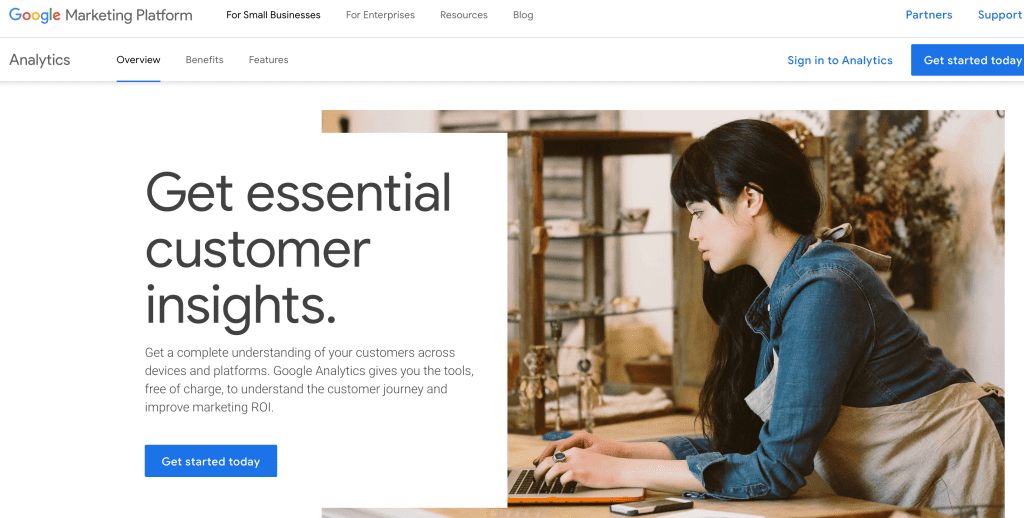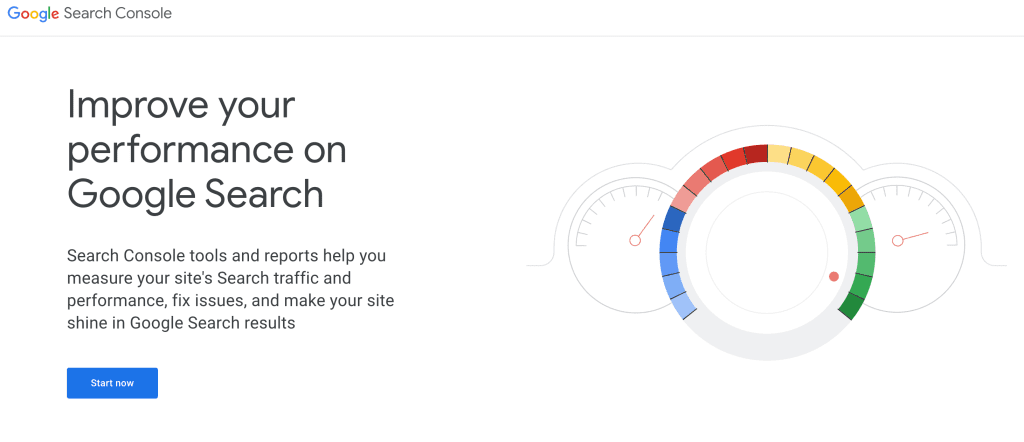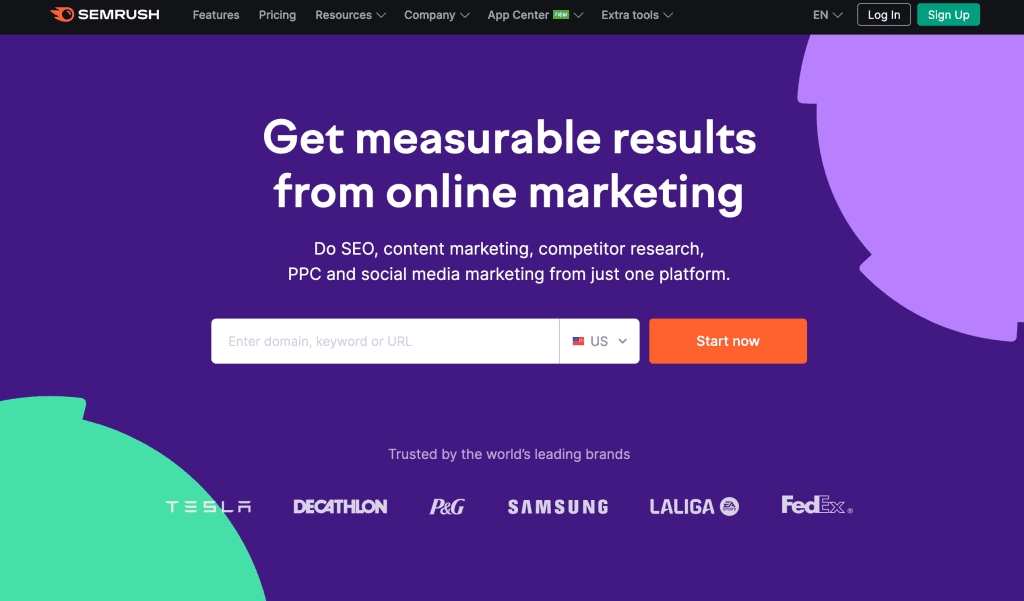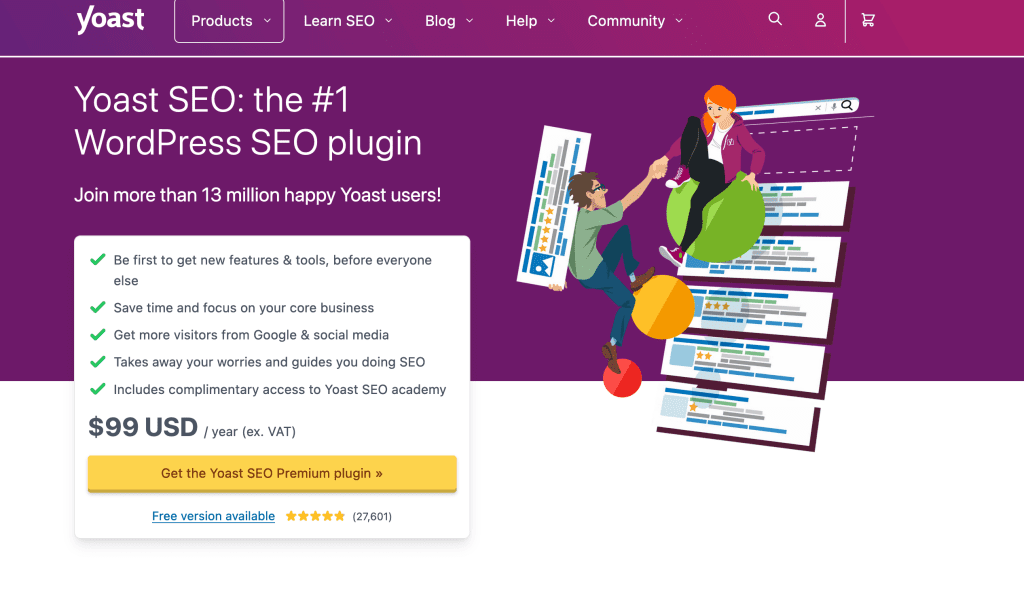Key Takeaways
- SEO Audits are the Cornerstone of Digital Success: Understand that SEO audits are not just a checklist of technical tasks but a strategic roadmap to improving your online presence. By conducting thorough audits, you can uncover issues, seize opportunities, and enhance your website’s performance in search engine rankings.
- Data-Driven Decisions are Crucial: Embrace the power of data in SEO. Use tools like Google Analytics, Google Search Console, and SEO software to track your progress, measure the impact of your efforts, and make informed decisions for continuous improvement.
- SEO is a Journey, Not a Destination: Recognize that SEO is an ongoing journey. The digital landscape evolves, algorithms change, and user behaviour shifts. Stay committed to learning, adapting, and refining your SEO strategies to stay ahead in the ever-competitive online world.
In the vast digital landscape that is the internet, visibility is key.
Whether you’re a fledgling blogger, a small business owner, or a seasoned e-commerce mogul, the success of your online presence hinges on one critical factor: Search Engine Optimization, or SEO.
Welcome to the world of SEO auditing – the foundation upon which your digital success story will be built.
Picture this: you’ve crafted an impeccable website, painstakingly designed it to be user-friendly, loaded it with top-notch content, and poured your heart and soul into it.
But there’s a problem – it’s akin to building a beautiful house in the middle of a dense forest without a road leading to it.
Without a well-structured SEO strategy and regular audits, your website may as well be invisible to countless online users searching for precisely what you offer.
So, what is an SEO audit, and why does it matter?
An SEO audit is the compass that guides you through the labyrinth of search engine rankings. It’s the flashlight that uncovers hidden issues and optimization opportunities within your website.
Whether you’re an SEO novice or a seasoned pro, this comprehensive guide is designed to demystify the art of SEO auditing and empower you to take control of your online destiny.
The digital age has transformed the way we live, work, and play.
We rely on search engines like Google, Bing, and Yahoo to navigate the vast online landscape, and these search engines, in turn, rely on sophisticated algorithms to serve up the most relevant content to users.
If your website isn’t optimized to meet these algorithms’ ever-evolving criteria, it could get lost in the virtual wilderness, rendering your hard work and valuable content virtually invisible.
Imagine your website as a book in a colossal library. SEO auditing is like ensuring that your book’s spine is labelled correctly, that the pages are well-organized and legible, and that your book is in the right section of the library for interested readers to find it.
Without this meticulous curation, your literary masterpiece might languish in obscurity.
However, SEO auditing is not a one-time event. The digital ecosystem is dynamic, with search engines continually tweaking their algorithms, competitors vying for the same audience, and user preferences evolving.
To stay ahead of the curve and maintain your digital relevance, regular SEO audits are essential. Think of it as tuning your instrument to keep producing harmonious melodies in an ever-changing symphony.
This beginner’s guide to SEO auditing is your passport to navigating the labyrinth of digital marketing successfully.
Whether you’re an enthusiastic entrepreneur just dipping your toes into the online world or a marketing maven looking to fine-tune your SEO strategies, this guide is tailored to meet you where you are on your journey.
We’ll start with the basics, ensuring that even if you’re entirely new to the concept of SEO, you’ll have a solid foundation to build upon. For those with some prior knowledge, fear not – we’ll delve into more advanced techniques and tips that will elevate your SEO game to new heights.
In the coming chapters, we’ll embark on a comprehensive exploration of SEO auditing. We’ll demystify the jargon, decode the algorithms, and equip you with the tools and knowledge necessary to not only understand the process but also to execute it effectively.
Here’s a sneak peek of what’s in store:
Understanding the Basics of SEO: We’ll kick things off by unraveling the fundamental concepts of SEO, so even newcomers can grasp the essentials.
The Anatomy of an SEO Audit: Get ready to dissect the core components of an SEO audit, understanding why each aspect matters and how it contributes to your online success.
Tools of the Trade: We’ll introduce you to a toolbox filled with indispensable SEO auditing tools and show you how to wield them like a pro.
On-Page Optimization: Dive into the nitty-gritty of optimizing your website’s individual pages, from content to meta tags and everything in between.
Off-Page Optimization: Discover the significance of off-page factors, such as backlinks and social signals, and learn how to harness their power.
Technical SEO: Uncover the mysteries of technical SEO, including site speed, mobile-friendliness, and structured data, ensuring your site is a well-oiled machine in the eyes of search engines.
Content Audit: Learn how to perform a content audit to ensure your website’s content is not only engaging but also search engine-friendly.
Local SEO: If you’re a local business, we’ve got you covered with strategies to dominate the local search results.
E-commerce SEO: E-commerce entrepreneurs will find valuable insights into optimizing their online stores for maximum visibility and profitability.
Tracking and Continuous Improvement: Discover how to track your SEO efforts and make data-driven decisions for ongoing optimization.
By the time you reach the end of this guide, you’ll be armed with the knowledge and expertise to conduct SEO audits that transform your online presence from a hidden gem into a shining beacon in the digital wilderness.
So, whether you’re a passionate blogger, a business owner looking to expand your online reach, or simply a curious explorer of the digital frontier, fasten your seatbelt and prepare for a journey that will demystify SEO auditing and empower you to conquer the online world.
Let’s embark on this adventure together, one step at a time, as we unravel the intricacies of SEO auditing and propel your digital success to new heights.
About AppLabx
From developing a solid marketing plan to creating compelling content, optimizing for search engines, leveraging social media, and utilizing paid advertising, AppLabx offers a comprehensive suite of digital marketing services designed to drive growth and profitability for your business.
AppLabx is well known for helping companies and startups use search engine optimisation to drive web traffic to their websites and web apps.
At AppLabx, we understand that no two businesses are alike. That’s why we take a personalized approach to every project, working closely with our clients to understand their unique needs and goals, and developing customized strategies to help them achieve success.
If you need a digital consultation, then send in an inquiry here.
Getting Started with SEO Audit: A Beginner’s Guide
- Understanding the Basics of SEO
- The Anatomy of an SEO Audit
- Tools of the Trade
- On-Page Optimization
- Off-Page Optimization
- Technical SEO
- Content Audit
- Local SEO
- E-commerce SEO
- Tracking and Continuous Improvement
1. Understanding the Basics of SEO
In the ever-evolving digital landscape, understanding the fundamentals of SEO (Search Engine Optimization) is crucial for anyone aiming to establish a strong online presence.
This section will delve into the core concepts of SEO, providing you with a solid foundation to build upon.
What is SEO?
Definition
SEO, or Search Engine Optimization, is the practice of optimizing your website to improve its visibility in organic (non-paid) search engine results.
The primary goal of SEO is to rank higher on search engine results pages (SERPs) for relevant keywords, thereby driving more organic traffic to your website.
Example:
Let’s say you have a website selling handmade jewellery.
When someone types “handmade jewellery” into a search engine like Google, SEO helps ensure that your website appears on the first page of results.
This visibility increases the likelihood that users will click on your site and potentially make a purchase.
Why is SEO Important?
The Significance of Organic Traffic
The importance of SEO becomes evident when considering the role of search engines in directing online traffic. According to recent studies, Google alone processes over 8.5 billion searches per day.
This immense volume of searches underscores the potential of SEO to drive a substantial portion of this traffic to your website.
Trust and Credibility
High-ranking websites are often perceived as more trustworthy and credible by users.
This highlights the importance of securing a top position through effective SEO practices.
Increased Traffic and Conversions
Investing in SEO can lead to a significant increase in both website traffic and conversions. Websites ranking on the first page of Google for a specific keyword are more likely to receive clicks and conversions. For instance, a study found that the first page of Google captures 71% of all clicks for a given search query.
How Do Search Engines Work?
The Search Engine Algorithm
Search engines like Google employ complex algorithms to determine which web pages are most relevant to a user’s query. These algorithms consider hundreds of factors when ranking pages.
Example:
Google’s algorithm assesses factors such as keyword relevance, website quality, backlinks, user experience, and more. By understanding how these factors influence rankings, you can tailor your SEO efforts to align with search engine preferences.
Crawling and Indexing
Search engines use automated bots, known as crawlers or spiders, to browse the web and index web pages. These bots follow links, analyze content, and store information in the search engine’s database.
Example:
Imagine these crawlers as diligent librarians who catalogue and organize every book in a vast library. When a user searches for information, the search engine can quickly retrieve relevant “books” (web pages) from its well-organized database.
SEO vs. SEM: Key Differences
SEO vs. SEM Definition
While SEO focuses on organic search results, SEM (Search Engine Marketing) involves paid advertising within search engines, commonly referred to as Pay-Per-Click (PPC) advertising.
Example:
Suppose you’re running a PPC campaign for your jewellery business. Your ads appear at the top of search results, and you pay a fee each time a user clicks on your ad.
In contrast, SEO aims to achieve similar visibility but without direct advertising costs, relying on optimizing your website’s content and structure.
Understanding these fundamental SEO concepts is the first step in your journey to harness the power of search engines and enhance your online visibility.
2. The Anatomy of an SEO Audit
An SEO audit is the compass that guides you through the labyrinth of search engine rankings.
It’s a systematic evaluation of your website’s health and performance in the eyes of search engines.
This section will break down the critical components of an SEO audit, providing you with insights into why each element is vital.
What is an SEO Audit?
Definition
An SEO audit is a comprehensive analysis of a website’s various elements to identify strengths, weaknesses, and optimization opportunities.
It serves as the foundation for making informed decisions to enhance a website’s search engine visibility and overall performance.
Example:
Imagine you have a blog about healthy cooking.
An SEO audit would involve a detailed examination of your blog, covering aspects like keyword usage, content quality, site speed, and more.
The audit would identify areas where your website excels and areas where improvements are needed to rank higher in search results.
Why is an SEO Audit Necessary?
Uncovering Hidden Issues
Even the most well-designed websites can harbour hidden issues that hinder their SEO potential.
An audit helps uncover issues such as broken links, duplicate content, or technical glitches that can negatively impact your rankings.
Data-Driven Decision Making
An SEO audit provides concrete data and insights. It enables you to make informed decisions based on quantitative and qualitative analysis rather than guesswork.
Staying Competitive
In a competitive digital landscape, staying ahead of competitors is crucial. Regular audits help you identify what your competitors are doing right and where you can outperform them.
Goals of an SEO Audit
Identify SEO Opportunities
An audit reveals opportunities to optimize your website for better search engine performance. These opportunities could include targeting new keywords, improving on-page elements, or enhancing user experience.
Detect and Fix Issues
Identifying and addressing issues is a primary goal of an SEO audit. These issues can range from technical problems that hinder crawling to content that doesn’t meet user intent.
Monitor Progress
An audit establishes a baseline for your website’s performance. Over time, you can conduct follow-up audits to measure progress and the impact of your SEO efforts.
Components of an SEO Audit
An SEO audit comprises several key components that collectively provide a comprehensive assessment of your website’s SEO health.
On-Page Factors
Keyword Analysis
Analyze your keyword strategy to ensure alignment with user intent and search trends. Are you targeting the right keywords, and are they integrated effectively into your content?
Content Quality
Evaluate the quality and relevance of your website’s content. Is it informative, engaging, and unique? Are there opportunities to improve existing content or create new, valuable pieces?
Meta Tags
Examine the optimization of meta title tags and meta descriptions. Are they compelling and relevant to the content on each page?
Off-Page Factors
Backlink Profile
Assess the quality and quantity of backlinks pointing to your site. Are there toxic or spammy links that need removal? What strategies can you employ to earn high-quality backlinks?
Social Signals
Analyze your social media presence and its impact on SEO. Are you leveraging social media effectively to drive engagement and traffic to your website?
Technical Factors
Site Speed
Page load speed is a critical factor for user experience and SEO. Use tools like Google PageSpeed Insights to identify areas for improvement.
Mobile-Friendliness
With the increasing use of mobile devices, it’s essential to ensure your website is mobile-responsive. Google’s mobile-first indexing prioritizes mobile-friendly sites.
Indexing and Crawlability
Check if search engine crawlers can access and index your website’s pages. Address issues such as broken links, 404 errors, and blocked resources.
An SEO audit is a multifaceted process that involves a deep dive into various aspects of your website.
As we explore each component in more detail in the subsequent sections, you’ll gain a comprehensive understanding of how to conduct a thorough SEO audit and make the necessary optimizations for improved search engine visibility.
3. Tools of the Trade
Effective SEO auditing relies on a robust set of tools designed to provide insights, track performance, and streamline optimization efforts.
In this section, we’ll explore the essential SEO tools that are crucial for conducting a comprehensive audit of your website.
The Role of SEO Tools
Streamlining Analysis
SEO tools simplify the process of gathering data and analyzing various aspects of your website’s performance. They automate tasks that would otherwise be time-consuming and error-prone.
Data-Driven Decision Making
These tools provide quantifiable data, allowing you to make informed decisions based on facts and metrics rather than guesswork.
Competitive Intelligence
Many SEO tools offer competitive analysis features, helping you understand how your website stacks up against competitors and identify opportunities for improvement.
Essential SEO Audit Tools
Google Analytics
Purpose: Google Analytics provides valuable insights into your website’s traffic, user behaviour, and conversion rates. It helps you understand how users interact with your site.

Example: By analyzing Google Analytics data, you can identify which pages have the highest bounce rates and take steps to improve their content or user experience.
Google Search Console
Purpose: Google Search Console offers critical information about your website’s presence in Google’s search results. It provides data on search queries, indexing status, and site performance.
Example: You can use Google Search Console to identify and fix crawl errors, submit sitemaps, and see which keywords are driving traffic to your site.

SEMrush
Purpose: SEMrush is an all-in-one SEO suite that offers features such as keyword research, competitive analysis, backlink auditing, and site auditing.
Example: By using SEMrush, you can discover which keywords your competitors are ranking for and develop strategies to outrank them.

Ahrefs
Purpose: Ahrefs is renowned for its backlink analysis capabilities. It provides detailed insights into your backlink profile, helping you identify high-quality links and areas for improvement.

Example: Ahrefs can help you detect and disavow toxic backlinks that may be harming your website’s SEO.
Moz Pro
Purpose: Moz Pro offers a suite of SEO tools, including site auditing, keyword research, and rank tracking. It’s particularly useful for comprehensive site audits.

Example: Moz Pro’s site audit feature can pinpoint issues like broken links, duplicate content, and missing meta tags, enabling you to rectify them promptly.
Screaming Frog SEO Spider
Purpose: Screaming Frog is a website crawling tool that provides a detailed analysis of your website’s structure, including broken links, redirects, and duplicate content.

Example: By using Screaming Frog, you can identify and fix on-page issues that may be hindering your SEO efforts.
Yoast SEO (WordPress Plugin)
Purpose: Yoast SEO is a popular WordPress plugin that helps you optimize your content for search engines. It provides real-time content analysis and suggestions for improvement.

Example: If you’re writing a blog post in WordPress, Yoast SEO will provide recommendations for optimizing your content, such as improving readability and adding relevant keywords.
Free vs. Paid SEO Tools
Budget Considerations
Many SEO tools offer both free and paid versions. While paid tools typically offer more features and data, free versions can still provide valuable insights for those on a budget.
Example: Google Analytics and Google Search Console are free tools that offer foundational data for SEO analysis. If you require more advanced features, you can consider investing in paid tools like SEMrush or Ahrefs.
Recommended SEO Tools
Research and Choose Wisely
Selecting the right SEO tools for your needs is crucial. Consider factors such as your website’s size, your specific goals, and your budget when choosing the tools to incorporate into your SEO auditing process.
Example: If your primary focus is backlink analysis, Ahrefs might be your tool of choice. However, if you need a comprehensive suite for various SEO tasks, SEMrush or Moz Pro may be better suited to your needs.
These SEO tools are the foundation of an effective SEO auditing process. By leveraging their capabilities, you can gather data, identify issues, and formulate strategies to enhance your website’s search engine visibility and overall performance.
4. On-Page Optimization
On-page optimization is a pivotal aspect of SEO that focuses on fine-tuning individual web pages to improve their search engine visibility and user experience.
In this section, we’ll delve into the key elements of on-page optimization, demonstrating why they matter and how to implement them effectively.
The Importance of On-Page SEO
Relevance to User Intent
According to a report, content relevance is one of the most critical on-page SEO factors. Pages that precisely match user search intent tend to rank higher.
Improved User Experience
A study found that 53% of mobile site visitors will leave a page that takes longer than three seconds to load. On-page optimization plays a crucial role in enhancing page load speed and overall user experience.
Key Elements of On-Page Optimization
Keyword Research and Usage
Purpose: Identifying and using relevant keywords strategically in your content is fundamental to on-page SEO. Keywords help search engines understand the content of your page and match it to user queries.
Example: If you have a fitness blog and want to rank for “best cardio exercises,” you would research related keywords and naturally incorporate them into your article.
Content Optimization
Purpose: Content is king in the world of SEO. High-quality, valuable content not only engages users but also signals to search engines that your page deserves a higher ranking.
Example: If you run an e-commerce site selling hiking gear, an in-depth guide on “Choosing the Right Hiking Boots” with detailed information and images would be valuable content.
Meta Tags Optimization
Purpose: Meta tags, including the title tag and meta description, provide a concise summary of your page’s content. Optimizing them can improve click-through rates from search engine results pages (SERPs).
Example: For a blog post about healthy smoothie recipes, a compelling title tag could be “Delicious and Nutritious Healthy Smoothie Recipes | Your Blog Name.”
URL Structure
Purpose: A clean and descriptive URL structure not only aids in SEO but also enhances user understanding of your page’s content.
Example: Instead of a vague URL like “www.example.com/page123,” use a descriptive one like “www.example.com/healthy-smoothie-recipes.”
Header Tags (H1, H2, etc.)
Purpose: Header tags help structure your content and signal its hierarchy to both users and search engines. They also provide opportunities to incorporate keywords.
Example: In an article about digital photography, the main heading (H1) could be “Mastering the Art of Digital Photography,” while subsections (H2) might include “Choosing the Right Camera” and “Editing Techniques.”
Internal Linking
Purpose: Internal links connect different pages on your website, helping users navigate and distributing link equity (SEO value) throughout your site.
Example: In a blog post about photography tips, you could include internal links to related articles on your site, such as “Beginner’s Guide to DSLR Cameras.”
User Experience (UX) and SEO
Purpose: A well-designed and user-friendly website not only keeps visitors engaged but also positively influences SEO. Google considers factors like mobile-friendliness, page speed, and overall site structure.
Example: Ensuring that your website is mobile-responsive and loads quickly on all devices enhances both user experience and SEO.
Data-Driven On-Page Optimization
Regular Performance Monitoring
Purpose: Frequently monitor key performance indicators (KPIs) like organic traffic, bounce rate, and time on page to identify areas for improvement.
Example: Using Google Analytics, you can track how users engage with your content and identify pages that need optimization.
A/B Testing
Purpose: A/B testing involves comparing two versions of a page to determine which one performs better. This data-driven approach can guide on-page optimizations.
Example: You can run A/B tests on elements like headlines, call-to-action buttons, or page layouts to improve conversion rates.
On-page optimization is an ongoing process that combines creative content creation with data-driven decision-making. By meticulously optimizing individual pages, you can enhance their visibility in search results and provide users with valuable, engaging content.
In the following sections, we’ll delve into specific strategies and techniques for effective off-page SEO.
5. Off-Page Optimization
Off-page optimization, often referred to as off-site SEO, is a critical facet of enhancing your website’s authority, credibility, and overall ranking on search engine results pages (SERPs).
In this section, we’ll explore the significance of off-page optimization, its key components, and effective strategies for success.
The Importance of Off-Page SEO
Backlinks as a Ranking Factor
Backlinks remain one of the top-ranking factors for search engines. A study found that pages with more backlinks tend to rank higher on Google.
Enhanced Credibility
According to the Edelman Trust Barometer, 63% of consumers trust search engines as their most trusted source for general news and information. A strong off-page SEO strategy contributes to your website’s trustworthiness.
Key Elements of Off-Page Optimization
Backlink Building Strategies
Purpose: Backlinks are links from other websites that point to your site. Earning high-quality backlinks from authoritative websites can significantly boost your SEO efforts.
Example: If you run a travel blog, getting featured in a well-known travel magazine’s online article about your destination can provide valuable backlinks.
Social Signals and SEO
Purpose: Social media engagement and shares can indirectly impact your SEO. While social signals themselves may not be direct ranking factors, they can increase your content’s visibility and attract potential backlinks.
Example: A well-shared blog post on social media can attract more readers, some of whom might link to it from their own websites or blogs.
Online Reputation Management
Purpose: Monitoring and managing your online reputation is essential for off-page SEO. Positive reviews and mentions can improve your brand’s image and indirectly influence your SEO.
Example: Encourage satisfied customers to leave reviews on platforms like Google My Business, Yelp, or industry-specific review sites.
Strategies for Effective Off-Page SEO
Link Building
Strategy: Implement a diverse link-building strategy that includes guest posting, influencer outreach, and content promotion. Focus on acquiring backlinks from reputable and relevant websites.
Example: If you have an e-commerce store selling hiking gear, collaborate with outdoor enthusiasts’ blogs to publish guest posts with backlinks to your product pages.
Content Marketing
Strategy: Create high-quality, shareable content that naturally attracts backlinks. Invest in creating resources, such as in-depth guides, infographics, and research reports, that others in your industry find valuable.
Example: A digital marketing agency might create a comprehensive “State of Digital Marketing 2023” report, which becomes a go-to resource for marketers and attracts backlinks from industry websites.
Social Media Engagement
Strategy: Active engagement on social media platforms can amplify your content’s reach and influence. Encourage followers to share and engage with your posts, expanding your content’s visibility.
Example: Use platforms like Instagram, Twitter, and LinkedIn to share industry insights, product updates, and engaging visuals that resonate with your target audience.
Online PR and Brand Mentions
Strategy: Build relationships with journalists, bloggers, and industry influencers who can mention and link to your website in their content. Be a reliable source of valuable information in your niche.
Example: An eco-friendly cleaning product company might establish connections with journalists covering sustainability topics, leading to mentions and backlinks in articles about eco-friendly products.
Local SEO and Citations
Strategy: For local businesses, focus on local SEO efforts. Ensure that your business information (name, address, phone number, or NAP) is consistent across online directories and listings.
Example: If you own a local bakery, maintaining accurate NAP information on platforms like Google My Business, Yelp, and Yellow Pages is crucial for local search visibility.
Data-Driven Off-Page Optimization
Backlink Analysis
Purpose: Use tools like Ahrefs, Moz, or SEMrush to conduct backlink analysis. Identify your existing backlinks, assess their quality, and explore opportunities to earn more.
Example: A backlink analysis might reveal that a popular industry blog has linked to your content. You can reach out to them for potential collaboration or guest posting.
Monitor Brand Mentions
Purpose: Set up alerts or use tools like Brand24 or Mention to monitor mentions of your brand or products online. Engage with mentions positively and ensure accurate information is shared.
Example: If a blogger writes a positive review of your product, acknowledge their mention and express gratitude. Responding to negative mentions promptly can also mitigate potential harm to your reputation.
Off-page optimization is the art of building a strong online presence and enhancing your website’s authority and credibility.
By implementing effective off-page SEO strategies, you can improve your website’s rankings, gain more organic traffic, and establish your brand as a trusted authority in your industry.
6. Technical SEO
Technical SEO is the backbone of a well-optimized website. It involves optimizing your site’s infrastructure and ensuring that it’s accessible and functional for both search engines and users.
This section explores the significance of technical SEO, its core components, and best practices for achieving technical excellence.
The Importance of Technical SEO
Site Speed and User Experience
According to a survey, if your website takes more than 3 seconds to load, 53% of mobile users will abandon it. Technical SEO helps improve site speed, providing a better user experience and reducing bounce rates.
Mobile Responsiveness
Mobile devices account for more than half of all web traffic, according to a report. Google’s mobile-first indexing prioritizes mobile-friendly websites, making mobile responsiveness crucial.
Core Components of Technical SEO
Site Speed Optimization
Purpose: Optimizing page load times is critical for user experience and SEO. Faster-loading pages tend to rank higher in search results and keep users engaged.
Example: Use tools like Google PageSpeed Insights to identify and fix issues that slow down your website, such as large image files or server response times.
Mobile-Friendly Design
Purpose: Ensure that your website is responsive and displays properly on various devices, including smartphones and tablets.
Example: Google’s Mobile-Friendly Test tool can evaluate your site’s mobile-friendliness and offer suggestions for improvement.
Crawlability and Indexing
Purpose: Search engine bots must effectively crawl and index your website’s pages. This ensures that your content is discoverable by users.
Example: Use a robots.txt file to specify which pages search engines can and cannot crawl, and submit an XML sitemap to Google Search Console for efficient indexing.
Schema Markup and Structured Data
Purpose: Schema markup helps search engines understand the context of your content, leading to more informative search results, known as rich snippets.
Example: If you run a recipe blog, adding schema markup to your recipes can result in rich snippets that display cooking times, ratings, and calorie counts in search results.
XML Sitemaps and HTML Sitemaps
Purpose: XML sitemaps provide search engines with a structured list of your website’s pages, making it easier for them to crawl and index. HTML sitemaps aid users in navigation.
Example: Regularly update your XML sitemap and submit it to Google Search Console to ensure that search engines are aware of your latest content.
Best Practices for Technical SEO
Regular Site Audits
Purpose: Frequent site audits help identify and address technical issues promptly, ensuring optimal website performance.
Example: Use tools like Screaming Frog SEO Spider to conduct regular site audits, identifying issues like broken links or missing meta tags.
HTTPS and Secure Connections
Purpose: Google considers website security a ranking factor. Switching to HTTPS not only boosts your SEO but also instills trust in your users.
Example: Many web hosting providers offer SSL certificates, making it relatively simple to implement HTTPS on your website.
Page Speed Optimization
Purpose: Accelerating your website’s load times improves user experience and can positively impact your search engine rankings.
Example: Compress images, leverage browser caching, and consider using a content delivery network (CDN) to enhance page speed.
Optimize for Core Web Vitals
Purpose: Google introduced Core Web Vitals as a ranking factor, focusing on user experience metrics like loading performance, interactivity, and visual stability.
Example: Use Google’s PageSpeed Insights or the Google Search Console Core Web Vitals report to identify and rectify issues affecting these metrics.
Canonicalization
Purpose: Use canonical tags to specify the preferred version of a page when duplicate content exists. This prevents SEO issues caused by duplicate content.
Example: If your blog has both a “www” and “non-www” version, set a canonical tag to indicate the preferred version to search engines.
Technical SEO is the foundation upon which your website’s visibility and user experience are built.
By prioritizing technical excellence and adhering to best practices, you can ensure that your website is not only accessible and functional but also primed for higher search engine rankings.
7. Content Audit
A content audit is a systematic examination of your website’s existing content to assess its quality, relevance, and performance.
This section will explore why content audits are crucial, how to conduct them effectively, and their role in improving your website’s SEO.
The Significance of Content Audits
Content Quality and Relevance
According to a report, high-quality, comprehensive content tends to rank better in search results. Content audits help ensure that your content meets these criteria.
User Engagement
A study found that companies that published 16 or more blog posts per month received 3.5 times more traffic than those that published 0-4 posts. Content audits can identify gaps in your content strategy.
Conducting a Content Audit
Inventory Your Content
Compile a list of all the pages and posts on your website. Tools like Screaming Frog SEO Spider can assist in generating a comprehensive list.
Content Evaluation
Purpose: Evaluate each piece of content for its quality, relevance, and performance.
Example: Assess whether your content is up-to-date, provides value to the audience, and aligns with your current SEO strategy. Make note of any content that needs improvement or removal.
Keyword Analysis
Purpose: Examine the keywords associated with each piece of content. Are they still relevant? Can you optimize the content further for target keywords?
Example: If you run a tech blog, a content audit might reveal that older articles could benefit from updated keywords to match current trends and search queries.
Backlink Analysis
Purpose: Identify backlinks to your content and assess their quality. Backlinks can significantly impact your content’s authority and SEO performance.
Example: Using tools like Ahrefs, evaluate which pieces of content have acquired backlinks from authoritative sources. Consider optimizing or expanding these articles to capitalize on their link equity.
Performance Metrics
Purpose: Examine performance metrics like page views, bounce rate, time on page, and conversion rates for each piece of content.
Example: If you find that a particular blog post has a high bounce rate and low engagement, it may need a content overhaul to make it more engaging and valuable to readers.
Making Informed Decisions
Content Updates and Refreshing
Purpose: Based on your audit findings, prioritize content updates, improvements, or complete overhauls to align with your SEO and user engagement goals.
Example: If you operate an e-commerce website, consider updating product descriptions, adding customer reviews, or improving product images to boost conversion rates.
Content Consolidation and Deletion
Purpose: During your content audit, you may identify thin or outdated content that doesn’t contribute to your SEO efforts. Consider consolidating similar pieces or removing low-value content.
Example: If your blog has multiple short articles on a similar topic, merging them into a comprehensive, authoritative guide can improve SEO and user experience.
Content Creation Strategy
Purpose: Use the insights from your audit to inform your content creation strategy. Identify gaps in your content portfolio and plan new content that aligns with your audience’s needs.
Example: If you run a health and wellness website, your audit might reveal a lack of content related to mental health. You can then create a series of articles addressing this topic.
Data-Driven Content Audits
Tracking and Monitoring
Purpose: Regularly track the performance of the content you’ve updated or created as a result of your audit. Monitor how it ranks in search results and its impact on traffic and conversions.
Example: Use Google Analytics to measure the change in organic traffic and user engagement on the pages you’ve optimized or created.
Iterative Content Strategy
Purpose: Content audits are not a one-time task. Continuously evaluate your content’s performance, conduct audits at regular intervals, and adjust your content strategy accordingly.
Example: Plan quarterly or semi-annual content audits to ensure that your website’s content remains aligned with your SEO goals and audience interests.
Content audits are a critical part of maintaining a well-optimized website. By conducting regular assessments and making data-driven decisions, you can enhance the quality and relevance of your content, leading to improved SEO performance and user engagement.
8. Local SEO
Local SEO is a specialized branch of search engine optimization that focuses on optimizing your online presence to attract and engage local customers.
Whether you run a brick-and-mortar store or offer local services, local SEO is essential for enhancing your visibility within your target geographic area.
In this section, we will explore the significance of local SEO, its key components, and strategies for success.
The Significance of Local SEO
Local Search Intent
According to a survey, 46% of all Google searches have local intent. People often use search engines to find local businesses, making local SEO critical for reaching potential customers.
Mobile Device Usage
The use of mobile devices for local searches has grown significantly. A study reports that 88% of local searches on mobile devices result in a call or visit to the business within 24 hours.
Key Components of Local SEO
Google My Business (GMB) Optimization
Purpose: Google My Business is a vital platform for local SEO. It allows you to manage your business listing on Google, providing essential information to potential customers.

Example: Ensure your GMB profile includes accurate business details, such as your name, address, phone number (NAP), business hours, and high-quality photos.
Local Keyword Research
Purpose: Research and target local keywords that are relevant to your business and the geographic area you serve.
Example: If you run a bakery in New York City, optimizing for keywords like “best bakery in NYC” or “NYC artisan bread” can attract local customers.
Local Link Building
Purpose: Acquire backlinks from local websites, directories, and authoritative sources to boost your local SEO authority.
Example: Getting featured in local news articles, blogs, or community directories with backlinks to your website can improve your local search ranking.
Online Reviews and Reputation Management
Purpose: Encourage and manage online reviews on platforms like Google, Yelp, and Facebook. Positive reviews can significantly influence potential customers.
Example: Respond promptly to reviews, both positive and negative. Address customer concerns and showcase your commitment to excellent service.
NAP Consistency
Purpose: Ensure consistent and accurate business information (name, address, phone number) across your website, social media profiles, and online directories.
Example: If your business address is “123 Main St.” on your website but “123 Main Street” on your GMB profile, it can lead to confusion. Consistency is key.
Strategies for Effective Local SEO
Local Content Creation
Strategy: Create location-specific content that caters to the interests and needs of your local audience.
Example: If you run a fitness centre, write blog posts like “The Best Outdoor Workout Spots in [Your City]” or “Healthy Eating Options in [Your City].”
Local SEO Audit
Strategy: Regularly conduct local SEO audits to identify and address any issues with your GMB profile, website, or online listings.
Example: Use tools like Moz Local to scan the web for inconsistencies in your business information.
Local Citations
Strategy: Ensure your business is listed accurately on prominent online directories and local citation websites.
Example: List your business on platforms like Yellow Pages, Yelp, TripAdvisor, and local Chamber of Commerce websites.
Localized Social Media Presence
Strategy: Use social media platforms to engage with your local audience. Share local events, promotions, and community involvement.
Example: Share photos and updates from local events you sponsor or participate in. Encourage user-generated content related to your business.
Data-Driven Local SEO
Performance Tracking
Purpose: Monitor the performance of your local SEO efforts by tracking metrics like website traffic, GMB engagement, and conversions.
Example: Use Google Analytics to measure the increase in local organic traffic and track how many website visitors converted into customers.
Google Analytics and GMB Insights
Purpose: Leverage Google Analytics and Google My Business Insights to gain insights into user behavior, including where your website traffic is coming from and how users engage with your GMB profile.
Example: Use these insights to refine your local SEO strategy. For instance, if you notice a significant uptick in GMB profile views after posting updates, consider posting more frequently.
Local SEO is essential for businesses aiming to capture their local market. By optimizing your online presence, engaging with your local community, and leveraging the power of local search, you can increase your visibility, attract local customers, and grow your business.
9. E-commerce SEO
E-commerce SEO is a specialized field of search engine optimization tailored to online retailers. It focuses on optimizing e-commerce websites to improve visibility, drive organic traffic, and boost sales.
In this section, we’ll explore why e-commerce SEO is crucial, its key components, and strategies to excel in the competitive online marketplace.
The Significance of E-commerce SEO
E-commerce Growth
According to a study, global e-commerce sales amounted to $4.28 trillion in 2020, and the trend continues to rise. E-commerce SEO plays a vital role in helping businesses tap into this enormous market.
Organic Search Traffic
BrightEdge reports that organic search drives 53.3% of all website traffic. Optimizing for e-commerce-specific keywords can attract potential customers who are ready to make purchases.
Key Components of E-commerce SEO
Keyword Research and Optimization
Purpose: Identify relevant keywords with high search intent that align with your products or categories.
Example: If you sell athletic shoes, target keywords like “best running shoes,” “affordable basketball sneakers,” or “women’s workout shoes.”
Product Page Optimization
Purpose: Optimize individual product pages for search engines and users to enhance their visibility and conversions.
Example: Ensure that each product page includes a detailed product description, high-quality images, customer reviews, and clear calls-to-action (CTAs).
User Experience (UX)
Purpose: A seamless and user-friendly shopping experience is essential for e-commerce success and SEO. A positive UX can lead to higher conversion rates.
Example: Implement features like a straightforward navigation menu, a mobile-responsive design, and a user-friendly checkout process.
Technical SEO for E-commerce
Purpose: Technical aspects like site speed, structured data, and crawlability significantly impact e-commerce SEO.
Example: Use schema markup to provide rich product information in search results, and optimize your website’s speed to prevent users from abandoning slow-loading pages.
Category Page Optimization
Purpose: Optimize category pages to improve the ranking of product listings within specific categories.
Example: Create informative category descriptions, use clear headings, and ensure that products within categories are well-organized and easy to browse.
Strategies for Effective E-commerce SEO
Content Marketing for E-commerce
Strategy: Produce informative and engaging content related to your products, such as buying guides, how-to articles, and product comparisons.
Example: If you sell kitchen appliances, create content like “The Ultimate Guide to Choosing the Right Blender” or “10 Must-Have Kitchen Gadgets for Home Chefs.”
Customer Reviews and Ratings
Strategy: Encourage and showcase customer reviews and ratings on your product pages. Positive reviews can build trust and boost conversions.
Example: Allow customers to leave detailed reviews and provide a user-friendly review submission process.
Also, do read our top article on how to get Google reviews easily “How to Get 5-Star Google Reviews for your Business“.
Optimized Product Images
Strategy: Use high-quality images with descriptive file names and alt text to improve image SEO.
Example: For an e-commerce site selling clothing, use images with multiple angles and close-ups of fabric textures. Include alt text like “Blue Floral Print Summer Dress.”
Data-Driven E-commerce SEO
Conversion Rate Tracking
Purpose: Monitor the conversion rates for different product pages to identify which ones need optimization.
Example: Use Google Analytics to track which product pages have the highest conversion rates and analyze why they perform well.
Keyword Performance Analysis
Purpose: Regularly assess the performance of keywords for your e-commerce products and adjust your strategy accordingly.
Example: Use keyword tracking tools to monitor keyword rankings and identify opportunities for improvement.
E-commerce SEO is a dynamic and competitive field, but it offers immense potential for businesses looking to thrive in the online marketplace.
By optimizing your product pages, providing a seamless user experience, and leveraging the power of content marketing, you can attract organic traffic and convert visitors into loyal customers.
10. Tracking and Continuous Improvement in SEO
The Significance of Tracking SEO Efforts
Tracking and continuous improvement are essential components of any successful SEO strategy.
In this section, we will explore the significance of tracking your SEO efforts, how to do it effectively, and how continuous improvement can lead to better rankings and user engagement.
Measuring ROI
Tracking your SEO efforts allows you to measure the return on investment (ROI) for your digital marketing activities.
According to a study, 61% of marketers consider improving SEO and growing their organic presence as their top inbound marketing priority.
Through tracking, you can determine which SEO tactics are delivering results and which may need adjustment or reallocation of resources.
Adapting to Algorithm Changes
Search engines like Google make thousands of algorithm changes each year, as revealed by a study. These changes can significantly impact your website’s search visibility.
Effective tracking enables you to stay adaptable and make necessary adjustments when search engine algorithms change.
By monitoring your SEO performance, you can promptly identify and address any negative impacts from algorithm updates, ensuring that your website remains competitive in search results.
Effective Tracking of SEO Efforts
To effectively track your SEO efforts, it’s crucial to monitor various aspects of your online presence and performance.
Here are key areas to focus on:
Keyword Performance Tracking
One of the fundamental aspects of SEO is monitoring how your target keywords are performing in search results over time.
Utilize tools like Google Analytics and Google Search Console to track the rankings, click-through rates (CTR), and impressions of your keywords.
This data helps you understand which keywords are driving organic traffic and which may require optimization or adjustment.
Traffic and User Behavior Analysis
Understanding how users interact with your website is essential for SEO.
This includes which pages they visit, how long they stay, and where they drop off.
Google Analytics provides invaluable insights into user behaviour, helping you identify popular pages, high bounce rates, and areas for improvement.
By analyzing user data, you can refine your content strategy and user experience to better meet the needs of your audience.
Backlink Analysis
Backlinks are a critical factor in SEO. Monitor the acquisition of new backlinks, analyze their quality, and assess their impact on your website’s authority.
Tools like Ahrefs and Moz can help you identify new backlinks and evaluate the domain authority of referring sites. By tracking your backlink profile, you can ensure that your link-building efforts are contributing positively to your SEO.
Content Performance Assessment
Content is at the heart of SEO. Evaluate how well your content is performing in terms of engagement, conversions, and rankings.
Analyze metrics such as page views, time on page, and conversion rates for your top-performing content.
Identify which pieces of content are driving the most organic traffic and conversions, and consider creating more content around similar topics or updating existing content to maintain its relevance and value.
Local SEO Tracking
For businesses with a local presence, local SEO tracking is essential. This includes monitoring your Google My Business (GMB) performance, local keyword rankings, and customer reviews.
Tools like Google My Business Insights allow you to track customer actions such as calls, direction requests, and website visits. By staying on top of your local SEO data, you can optimize your online presence for local search and attract nearby customers effectively.
The Role of Continuous Improvement
Continuous improvement is the driving force behind SEO success. It involves using data and insights from your tracking efforts to make strategic enhancements to your SEO strategy. Here are key areas where continuous improvement plays a crucial role:
Keyword Optimization
Continuous improvement in SEO begins with keyword optimization. Regularly revisit your target keywords and adjust your content to align with evolving search trends.
For instance, if you run a technology blog, update articles to include new industry terms or trending keywords. By staying up-to-date with keyword trends, you can maintain or improve your search rankings.
Content Updates
Content is not static; it should evolve over time to remain relevant and competitive. Identify and refresh outdated content to keep it current and valuable to your audience.
Review older blog posts and add new information, update statistics, and include current examples. Content updates demonstrate to search engines that your website provides fresh and authoritative information.
Technical SEO Enhancements
Technical aspects like site speed, mobile-friendliness, and structured data significantly impact SEO. Continuous improvement in technical SEO involves regularly conducting technical audits and implementing improvements to enhance site performance.
Optimize images, update plugins, and maintain a clean and efficient website structure to provide an excellent user experience and maintain search engine favour.
Link Building
Link building is an ongoing process that requires continuous attention. Continue building high-quality backlinks and monitor your link profile to ensure its health. Engage in guest posting, outreach, and partnerships to acquire authoritative backlinks.
A steady flow of high-quality backlinks enhances your website’s authority and search engine rankings over time.
Data-Driven Continuous Improvement
Data-driven decision-making is at the core of continuous improvement in SEO. Here are strategies and tools that can help you refine your SEO efforts based on data:
A/B Testing
A/B testing allows you to experiment with different elements on your website to determine which variations perform best. For example, you can test different call-to-action (CTA) button colours, headlines, or product descriptions to improve conversion rates.
By systematically analyzing A/B test results, you can make data-driven decisions to enhance user engagement and conversion rates.
Conversion Rate Optimization (CRO)
Conversion rate optimization (CRO) involves analyzing conversion rate data to identify bottlenecks in your sales funnel and make necessary improvements. Tools like Google Optimize enable you to run A/B tests and optimize landing pages for better conversions.
By continuously refining your CRO strategy, you can maximize the value of your organic traffic and improve your website’s overall performance.
Competitor Analysis
Competitor analysis is an ongoing process that helps you understand your competitive landscape.
Regularly monitor your competitors’ SEO strategies and learn from their successes and failures. Identify your top competitors and analyze their backlink profiles, content strategies, and keyword rankings.
By keeping a close eye on your competitors, you can adapt your SEO strategy to stay ahead in the digital marketplace.
Tracking and continuous improvement are not mere components of SEO; they are the driving force behind its success.
By consistently monitoring your SEO efforts, analyzing data, and making data-driven improvements, you can adapt to changing search trends, enhance user experience, and ultimately improve your website’s rankings and performance in search engines.
Conclusion
In the ever-evolving landscape of digital marketing, mastering the art of SEO auditing is your key to unlocking online success.
In this comprehensive beginner’s guide, we embarked on a journey to demystify the intricate world of SEO audits, equip you with essential tools, knowledge, and strategies, and empower you to take control of your digital destiny.
We began by understanding that SEO audits are not mere technical checklists; they are your roadmap to digital excellence.
They are the compass that guides your website through the complex terrain of search engine rankings, helping you reach the coveted summit of the search results pages.
We laid the foundation by delving into the basics of SEO, uncovering the significance of keywords, meta tags, and the user experience.
Armed with the knowledge that SEO is not just about search engines but about enhancing user experiences, we set out to optimize our websites for both man and machine.
Our journey then led us through the intricate anatomy of an SEO audit. We learned that it comprises multiple facets, each as critical as the other. From technical SEO to content audits, from on-page optimization to off-page strategies, we explored it all.
We understood that a successful SEO audit is a symphony where every instrument must harmonize to produce beautiful search engine rankings.
Equipped with the right tools, we uncovered the secrets of SEO audits. We learned to navigate the digital terrain efficiently, extracting insights from tools like Google Analytics, Google Search Console, Moz, Ahrefs, Screaming Frog, and many others.
These tools became our allies, helping us make data-driven decisions and measure the impact of our efforts.
With a firm grip on the basics, we dived deep into the world of on-page optimization.
From crafting compelling content to optimizing meta tags, from understanding the power of internal linking to harnessing the magic of structured data, we fine-tuned our on-page elements to ensure they resonated with both users and search engines.
We recognized that SEO extends beyond our website’s borders. Off-page optimization became our strategy for building a credible digital presence.
We learned to acquire high-quality backlinks, engage with the online community, and leverage the power of social media to amplify our reach.
Our journey into the world of SEO audits would have been incomplete without mastering the technical aspects. Site speed, mobile responsiveness, XML sitemaps, canonicalization – these became not just buzzwords but vital components of our SEO arsenal.
We understood that the foundation of SEO rests on a technically sound website that search engines can crawl and index with ease.
In the digital age, content reigns supreme. We embarked on a quest to ensure our content was not just a king but an emperor. Content audits taught us to assess quality, relevance, and performance.
Armed with this knowledge, we knew how to breathe new life into outdated content, strengthen our keyword strategies, and provide genuine value to our audience.
Recognizing the importance of local search, we ventured into the world of local SEO. Whether you operate a brick-and-mortar store or offer services within a geographic area, local SEO is your compass.
It guides local customers to your doorstep, ensures your business is found on Google Maps, and fosters trust within your community.
In the bustling digital marketplace, e-commerce SEO has become our weapon of choice. We explored the intricacies of optimizing product pages, enhancing user experiences, and competing in the online retail arena.
Armed with e-commerce SEO strategies, we were poised to capture our share of the trillion-dollar e-commerce market.
Finally, we understood that in the dynamic world of SEO, standing still is akin to moving backwards. Tracking our SEO efforts became second nature, and continuous improvement was our mantra.
By making data-driven decisions, we could adapt to algorithm changes, optimize keywords, refresh content, and maintain technical excellence.
As we conclude our beginner’s guide to SEO audits, we recognize that this journey is just the beginning. SEO is not a static destination; it’s an ever-evolving expedition.
It’s a commitment to excellence in the digital realm, a pursuit of visibility, and a promise to your audience that you’re there to provide value.
Whether you’re a business owner, a digital marketer, a content creator, or an aspiring SEO guru, remember that SEO is not a one-size-fits-all solution. It’s a personalized adventure that requires constant learning, adaptation, and innovation.
So, as you embark on your SEO odyssey, armed with the knowledge and insights from this guide, remember that every audit, every optimization, and every piece of valuable content you create is a step forward in your digital journey.
Keep tracking, keep improving, and keep exploring new horizons in the vast universe of SEO. Your path to digital excellence has just begun. Happy optimizing!
If you are looking for a top-class digital marketer, then book a free consultation slot here.
If you find this article useful, why not share it with your friends and business partners, and also leave a nice comment below?
We, at the AppLabx Research Team, strive to bring the latest and most meaningful data, guides, and statistics to your doorstep.
To get access to top-quality guides, click over to the AppLabx Blog.
People also ask
What is an SEO audit, and why is it important for beginners?
An SEO audit is a comprehensive evaluation of a website’s performance in search engines. It’s crucial for beginners as it helps identify areas for improvement, ensuring your website ranks higher and attracts more organic traffic.
What are the key steps in conducting a beginner-friendly SEO audit?
Beginner-friendly SEO audits involve assessing on-page elements, technical SEO, content quality, and backlinks. It’s essential to start with keyword research and optimize meta tags.
How can beginners utilize tools like Google Analytics and Search Console for SEO audits?
Beginners can use Google Analytics to track website traffic, while Google Search Console provides insights into search performance, crawl issues, and keyword data—both are vital for audits.
































